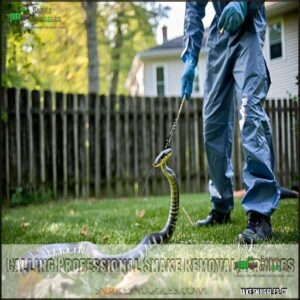This site is supported by our readers. We may earn a commission, at no cost to you, if you purchase through links.
 Ready to bring a slithery companion home? Before you get a snake, you’ll need to research specific species, habitat requirements, and care techniques.
Ready to bring a slithery companion home? Before you get a snake, you’ll need to research specific species, habitat requirements, and care techniques.
Choose between popular beginner snakes like corn snakes or ball pythons, which are docile and relatively low-maintenance. Consider your living space, budget, and time commitment carefully.
Check local regulations regarding snake ownership and make certain you’ve got a proper enclosure with precise temperature and humidity controls.
Learn about feeding requirements—most pet snakes eat frozen-thawed rodents. Budget for ongoing veterinary care from a reptile specialist.
Remember, snakes aren’t cuddly pets; they’re fascinating reptiles requiring dedicated, scientific care. Your future scaled friend awaits—are you prepared?
Table Of Contents
- Key Takeaways
- Identifying Common Types of Snakes
- Understanding Snake Behavior and Habits
- Creating a Snake-Friendly Environment
- Snake Handling and Safety Tips
- How to Remove a Snake From Your Home or Property
- Preventing Snake Bites and First Aid for Snake Bites
- Common Misconceptions and Myths About Snakes
- Protecting Pets and Children From Snakes
- Living With Snakes: Coexistence and Conservation
- Frequently Asked Questions (FAQs)
- How do I find a snake?
- How do I choose a snake?
- What should I do if I see a snake?
- How do I find a good place for a snake?
- What should I know before getting a snake?
- How do you pick up a snake?
- How do I Choose my first pet snake?
- Are pet snakes a good choice for a beginner?
- What should I consider when buying a pet snake?
- What should I look for in a snake?
- Conclusion
Key Takeaways
- You’ll need to research specific snake species carefully, focusing on beginner-friendly options like corn snakes or ball pythons that match your experience level and lifestyle. These docile reptiles require dedicated scientific care and aren’t cuddly pets.
- Before bringing a snake home, you’ll have to check local regulations, prepare a precise habitat with temperature and humidity controls, and budget for ongoing veterinary care from a reptile specialist. Your enclosure and care approach are critical to your snake’s survival.
- You’ll want to learn essential snake handling safety techniques, including how to identify venomous versus nonvenomous species, use proper handling tools like snake hooks, and understand snake behavior to minimize bite risks. Knowledge truly is your best defense against potential snake encounters.
- You’ll need to create a snake-unfriendly environment by removing potential attractants like wood piles, tall grass, and debris, while also implementing strategic yard cleanup and snake-proofing measures. Your proactive approach can dramatically reduce unexpected snake interactions on your property.
Identifying Common Types of Snakes
You’ll want to learn how to identify snake types quickly and accurately to guarantee your safety and understanding.
By focusing on key visual characteristics like head shape, pupil type, and color patterns, you’ll become skilled at distinguishing between venomous and nonvenomous species in no time, which is crucial for your safety.
Characteristics and Pictures of Venomous Snakes
At the crossroads of survival, venomous snakes reveal their deadly signatures.
When encountering these serpentine predators, knowledge is your shield. Check these telltale markers:
- Triangular snake heads – A venom warning sign
- Elliptical pupils – Nature’s predator indicator
- Vibrant red, yellow, and black patterns – Screaming "danger!"
- Defensive hissing – A threat communication signal
- Unique reptilian markings – Your first identification clue
Understanding venomous snake species is vital for safety.
Stay sharp, stay safe.
Characteristics and Pictures of Nonvenomous Snakes
Your snake identification skills can reveal a fascinating world of nonvenomous species.
Garter snakes rock bold stripes and thrive near water, feasting on amphibians. Rat snakes, dressed in sleek brown or black, patrol farmlands and woodlands like nature’s rodent control experts.
Kingsnakes—with their striking black and white bands—dominate forests and prairies, famously eating other snakes.
These harmless species share key characteristics: round pupils, smooth color morphs, and predictable patterns. Pro tip: Always consult detailed snake pictures and identification guides to confidently distinguish between nonvenomous snake species and their venomous counterparts.
Understanding Snake Behavior and Habits
Understanding snake behavior isn’t just about survival, it’s about appreciating these fascinating reptiles in their natural habitat.
You’ll discover how snakes hunt, reproduce, and adapt to their environments through careful observation and scientific analysis of their complex biological systems, which helps in appreciating these fascinating reptiles.
Snake Diet and Hunting Patterns
After identifying snake species, you’ll want to understand their remarkable hunting prowess. Snakes are master predators with extraordinary carnivorous diets that showcase nature’s precision.
Their feeding habits reveal fascinating survival strategies:
- Pythons strike with lightning-fast precision
- Heat-sensing abilities guide prey detection
- Hunting techniques vary by species
- Most snakes consume entire prey whole
- Movement patterns confuse potential victims
These carnivorous hunters employ sophisticated prey capture methods, utilizing scent, sight, and heat to track meals. Their unique digestion process allows them to survive on infrequent feedings, turning each hunt into a calculated survival mission.
Snake Reproduction and Nesting
The serpent’s world of reproduction unfolds like a complex dance, revealing nature’s intricate breeding strategies.
Snake courtship rituals captivate researchers and enthusiasts alike.
Here’s what you’ll discover about their remarkable reproductive journey:
- Females strategically choose safe, temperature-controlled nesting sites
- Some species lay eggs, while others birth live young
- Hatchling survival depends on precise environmental conditions
Breeding techniques vary dramatically across different snake species, showcasing their remarkable adaptability. The process is a delicate balance of factors, ultimately leading to the survival of the species, influenced by environmental conditions and nesting sites.
Creating a Snake-Friendly Environment
You’ll want to transform your outdoor space into a scientifically strategic habitat that minimizes snake interactions while maintaining ecological balance.
By understanding and implementing targeted landscape modifications, you can effectively reduce the likelihood of unwanted snake encounters on your property, which helps achieve a better ecological balance.
Removing Attractants for Snakes
After understanding snake behaviors, homeowners can transform their yards from potential wildlife habitats into inhospitable zones.
Strategic yard cleanup disrupts snake-friendly environments. Remove wood piles, old equipment, and overgrown vegetation that create attractive hiding spots. Secure potential food sources like pet dishes and birdseed.
Regularly manage debris and maintain short grass. Implement pest control strategies to reduce rodent populations. These targeted actions make your property less appealing to slithering visitors, effectively minimizing unexpected snake encounters.
Effective yard cleanup requires the right yard cleanup tools to remove debris and clutter, which is a crucial step in creating an inhospitable zone for snakes and ultimately achieving a snake-free environment through strategic cleanup.
Implementing Snake-Proofing Measures
After clearing unwanted vegetation, your next defense against slithery invaders is strategic snake proofing. Seal entry points scrupulously—inspect window frames, foundation cracks, and pet doors for potential snake highways.
Install hardware cloth fencing with tight mesh to block reptilian access. Remove yard debris that offers hiding spots, creating an inhospitable landscape.
Professional home inspection can reveal subtle vulnerabilities. By systematically blocking snake escape routes and maintaining a clean perimeter, you’ll transform your property into an impenetrable fortress against unexpected reptilian visitors.
Effective snake proof fencing requires careful consideration of snake barrier systems.
Snake Handling and Safety Tips
Encountering a snake can be a heart-pounding experience that demands quick, precise action and nerves of steel.
You’ll need to master essential safety techniques, understand snake behavior, and learn how to protect yourself while respecting these fascinating reptiles.
What to Do if You Encounter a Snake
Your heart rate’s about to skyrocket when a snake crosses your path, but cool heads prevail in wild encounters.
Stay calm, move slowly. In snake encounters, your steady nerves are your greatest survival tool.
A snake removal guide demands precision and calm:
- Freeze Frame: Notice its silhouette and markings
- Spatial Awareness: Measure distance, calculate escape routes
- Strategic Retreat: Back away slowly, avoiding sudden movements
Snake safety precautions aren’t about heroics—they’re survival tactics. These wild encounters require steady nerves and rational thinking.
Professional snake removal experts recommend maintaining a safe perimeter, avoiding direct confrontation, and respecting the creature’s natural instincts. Your emergency response? Stay calm, stay back, stay alive.
Understanding proper snake handling safety is essential for preventing accidents and ensuring a safe outcome.
Proper Techniques for Handling Snakes
After spotting a snake, your next move matters.
Safe snake handling requires precision and calm nerves.
Use gloves, tongs, and snake hooks to minimize direct contact while maintaining control.
Support the snake’s entire body—never grab just the tail.
| Tool | Purpose | Technique | Safety Level | Effectiveness |
|---|---|---|---|---|
| Snake Hook | Positioning | Distance Control | High | Excellent |
| Thick Gloves | Protection | Direct Handling | Medium | Good |
| Tongs | Restraint | Gentle Grip | High | Very Good |
| Pillowcase | Transportation | Temporary Containment | Medium | Moderate |
| Snake Tube | Secure Movement | Controlled Passage | High | Excellent |
Release slowly, respecting the snake’s natural movement.
This approach ensures a safe and controlled environment for both the handler and the snake.
How to Remove a Snake From Your Home or Property
When you discover a snake in your home or on your property, it’s vital to act quickly and carefully to safeguard your safety.
You’ll want to assess the situation, identify the type of snake, and choose the most appropriate removal method, whether that means calling a professional or using a careful do-it-yourself technique.
Calling Professional Snake Removal Services
When an unexpected serpent slithers into your space, most homeowners freeze—but professional snake removal services can turn panic into quick resolution.
These licensed experts deploy specialized snake control methods that prioritize both human and reptilian safety. Emergency calls connect you with trained professionals who conduct thorough snake inspections using precise removal techniques.
Their service providers understand local wildlife behavior, ensuring humane extraction and offering preventative advice. Removal costs vary, but the peace of mind is invaluable.
DIY Methods for Snake Removal
After professional snake removal services, taking matters into your own hands requires careful strategy. When facing an unwelcome serpent, arm yourself with smart DIY techniques:
- Use snake hooks for safe, controlled handling
- Deploy humane snake traps with precision
- Sprinkle natural DIY deterrents around property
- Apply snake removal tools methodically
- Create barriers blocking potential entry points
Using proper snake hook tools is essential for safe handling. Your snake removal guide transforms uncertainty into confident action. With the right approach, you’ll navigate this slithery challenge like a pro, ensuring your space remains snake-free while respecting wildlife’s delicate balance.
With the right tools and techniques, you can ensure a safe and effective snake removal process, making your space snake-free while also respecting the environment.
Preventing Snake Bites and First Aid for Snake Bites
You’ll want to understand how to protect yourself from potentially dangerous snake encounters and learn critical first aid techniques.
Whether you’re hiking, working outdoors, or living in snake-prone areas, knowing how to prevent bites and respond effectively can save your life in critical moments.
Snake Bite Prevention Tips
After safely removing snakes from your property, preventing future encounters becomes your top priority.
Snake Avoidance starts with smart strategies that keep you out of harm’s way.
Wear snake-proof boots and stick to clear paths when exploring outdoor areas.
Your yard’s landscape matters—eliminate tall grass, wood piles, and debris that create snake hiding spots.
Stay alert and move calmly if you encounter a snake.
Remember, most snakes want to avoid you more than you want to avoid them.
By understanding snake behavior and implementing targeted Safety Precautions, you’ll dramatically reduce bite risks.
It’s vital to know proper snake bite first aid techniques to guarantee effective treatment in case of an emergency, using proper techniques for the best outcome with effective treatment.
Steps to Take if Bitten by a Snake
When a snake strike catches you off guard, your next moves could save your life. Immediately call 911 and remain calm—panicking won’t help.
- Keep the bite site below heart level
- Remove tight clothing or jewelry near wound
- Document snake’s appearance if possible
- Wash bite area gently with soap and water
Immobilize the affected area and wait for medical professionals who’ll administer anti-venom treatment swiftly and safely.
Common Misconceptions and Myths About Snakes
You’ve likely heard wild tales about snakes that’ll make your skin crawl, but it’s time to separate fact from fiction.
In this section, we’ll unravel the most persistent myths and misconceptions about these fascinating reptiles, helping you understand their true nature and dispel the fears that often surround them.
Debunking Myths About Snake Behavior
Let’s clear up some snake myths that’ll make your skin crawl.
Most snake myths are pure fiction—these creatures are survival experts, not Hollywood monsters.
Contrary to popular belief, snakes don’t chase people—they’re more about defense than attack. Their movement might seem purposeful, but they’re simply exploring their environment.
Forget those scare tactics: these creatures rely on vibration detection and survival instincts, not Hollywood-style aggression. Understanding snake behavior means recognizing they’re not villains, but intelligent creatures adapting to their habitat.
Venom misconceptions aside, snakes are complex animals driven by survival, not malice. Knowledge dispels fear. By studying snake behavior patterns, we can better understand their actions and motivations.
Addressing Misconceptions About Snake Safety
A slice of snake reality might surprise you: not every serpent spells danger.
Snake myths often paint these creatures as aggressive predators, but most species actively avoid human contact.
Key snake safety precautions involve identifying venomous species through distinctive features like triangular heads and elliptical pupils.
Venom facts reveal that snakes typically strike only when threatened, making calm, slow movements your best bite prevention strategy.
Understanding snake awareness helps transform your perspective from fear to respect.
By embracing snake safety tips and learning about these misunderstood reptiles, you’ll recognize they’re essential ecosystem players.
Knowledge truly is your best defense against snake misconceptions.
Protecting Pets and Children From Snakes
You’ll need to be proactive and educated to protect your pets and children from potential snake encounters in your environment.
By understanding snake behavior, identifying local species, and implementing strategic safety measures, you can substantially reduce the risk of dangerous snake interactions.
Pet Safety Tips to Prevent Snake Encounters
Four out of five pet owners remain unaware of critical snake safety strategies.
Protect your furry companions by implementing thorough snake deterrents and outdoor precautions.
Consider these essential steps:
- Maintain a pristine yard through regular cleanup, removing potential snake hiding spots.
- Install robust pet fencing with minimal ground gaps to block snake intrusions.
- Invest in professional snake avoidance training for dogs and outdoor pets.
Your strategic approach can dramatically reduce snake bite risks.
By combining yard maintenance, physical barriers, and targeted training, you’ll create a safer environment where pets can roam without constant worry about unexpected reptilian encounters.
Child Safety Measures for Snake Awareness
Since early childhood, learning snake safety can turn an anxiety-provoking topic into an empowering adventure.
Teach your kids to stay alert in outdoor environments by wearing thick leather boots and avoiding tall grass.
Practice walking on designated trails, making deliberate footsteps to signal your presence, and educate children about maintaining distance, staying calm, and immediately notifying adults if they spot a snake nearby, which can be a life-saving action.
Living With Snakes: Coexistence and Conservation
If you want to successfully coexist with snakes, you’ll need to understand their critical role in maintaining ecological balance and biodiversity.
By learning about snake behavior, habitat requirements, and conservation strategies, you can transform your perspective from fear to appreciation and develop responsible interactions with these fascinating reptiles, which is essential for maintaining ecological balance.
The Importance of Snakes in Ecosystems
Worried about snakes in your backyard? Understanding their ecological significance can transform your perspective.
These incredible wildlife guardians play a critical role in maintaining ecosystem balance:
- Control rodent populations
- Reduce agricultural pest damage
- Support intricate food web dynamics
- Enable wildlife conservation efforts
Snakes are nature’s unsung heroes, protecting biodiversity by regulating prey species and supporting complex ecological interactions. Their presence signals a thriving, healthy environment.
Promoting Harmony Between Humans and Snakes
The humble backyard ecosystem thrives when snakes play their natural role.
Understanding snake behavior and wildlife preservation helps humans develop better coexistence strategies.
By learning snake handling techniques and species research, you’ll transform fear into respect for these critical predators.
Snake conservation efforts start with awareness—recognizing their importance in maintaining ecosystem balance.
Your proactive approach can protect both local wildlife and human communities.
Educate yourself about snake safety tips, create snake-friendly environments, and share knowledge that promotes harmony between humans and these misunderstood creatures.
Frequently Asked Questions (FAQs)
How do I find a snake?
You’ll find snakes at reptile shows, specialty pet stores, online marketplaces, and through reputable breeders.
Check local exotic pet regulations, research species carefully, and prioritize health and ethical sourcing when selecting your new serpentine companion.
How do I choose a snake?
Like a treasure hunter picking the perfect gem, you’ll want to research beginner-friendly snakes that match your experience level, habitat space, and lifestyle.
Consider ball pythons, corn snakes, or rosy boas for your first slithery companion, and remember to choose a snake that fits your lifestyle and experience level.
What should I do if I see a snake?
Stay calm, freeze, and back away slowly when you see a snake.
Don’t make sudden moves. Identify its type from a safe distance.
Move away carefully, avoiding tall grass.
Seek professional help if it’s near your home, especially if you see a snake.
How do I find a good place for a snake?
You’ll want a spacious, quiet habitat mimicking natural conditions.
Choose an enclosure with secure lid, temperature gradient, hiding spots, and minimal disturbances—ideally away from high-traffic areas in your home’s calm, stable environment.
What should I know before getting a snake?
Research snake species thoroughly, checking legal requirements, care needs, and your lifestyle compatibility.
Choose a beginner-friendly snake like a corn snake or ball python.
Consult reptile experts and prepare a proper habitat before bringing your scaly friend home.
How do you pick up a snake?
With snake handling injuries affecting over 7,000 people annually, always support a snake’s entire body when picking it up.
Use gentle, confident movements, approaching from the side to prevent startling the reptile.
How do I Choose my first pet snake?
You’ll want a beginner-friendly snake like a corn snake or ball python.
Check its health, temperament, and compatibility with your lifestyle.
Consult experts, handle carefully, and prioritize proper care and legal considerations.
Are pet snakes a good choice for a beginner?
If you’re just dipping your toes into reptile ownership, beginner-friendly snakes like corn snakes or ball pythons can be your gateway.
They’re docile, low-maintenance, and perfect for learning the ropes of exotic pet care.
What should I consider when buying a pet snake?
You’ll want to assess your lifestyle, choose a beginner-friendly species like corn or ball pythons.
Verify local regulations, consult reptile experts, and understand the long-term commitment of snake ownership.
Before bringing home your scaly companion, ensure you have considered all aspects, including the long-term commitment.
What should I look for in a snake?
When choosing a snake, inspect for vibrant scales, clear eyes, and alert behavior.
Check its body condition, verify species compatibility with your experience level, and confirm legal ownership in your area before bringing it home.
Conclusion
Ultimately, your journey into snake ownership is like traversing a fascinating ecosystem of scales and survival.
By mastering the nuances of "how to get a snake complete guide with pictures", you’ll transform from a novice to a confident reptile guardian.
Whether you’re drawn to a corn snake’s gentle demeanor or a ball python’s unique personality, remember that responsible care, continuous learning, and respect for these remarkable creatures will guarantee a rewarding companionship that bridges human understanding and reptilian wonder.

















